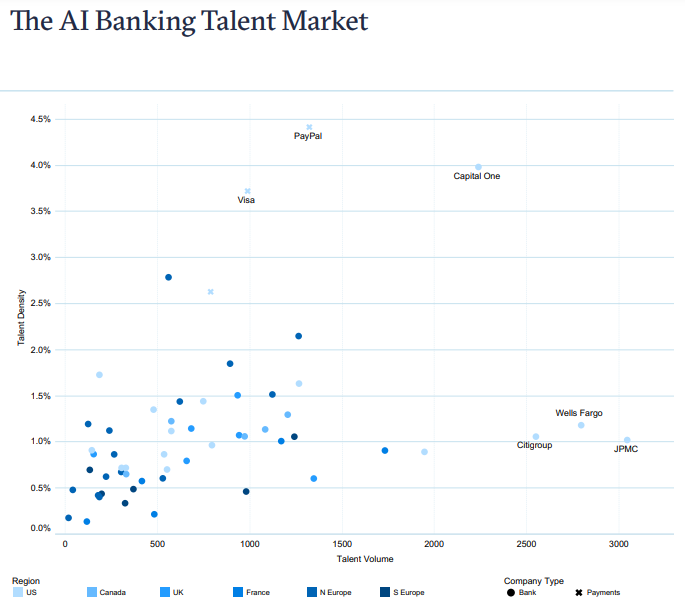Making artificial intelligence (AI) work in banks requires a combination of roles and skill sets: data scientists, data engineers, ML engineers, software developers, subject matter experts, quants, model risk analysts, policy and governance managers to name but a few.
Bringing these skill sets together requires meticulous management and a board that understands the challenges and opportunities of deploying AI. Although there is evidence of people working in AI in banks with decades worth of experience this is still a relatively new field. This can mean that there is little consistency in nomenclature across the banks, let alone a single view of best practice.
In this report, research firm Evident tracks the broad groups of people who make up the AI ecosystem inside our featured banks to try to make sense of the evolving talent stack.
15 points
1. The 60 largest North American and European banks and payment providers employ at least 46,000 people in the “AI & Data Core” (AI development, data engineering and governance & ethics roles), with as many as 100,000 global banking roles (including Implementation, Quants and Model Risk) involved in bringing AI to market.
2. Even as banks cut jobs and institute hiring freezes they continue to invest in AI. AI & Data Core net staff numbers are up 4% from October 2022 to March 2023 – and 40% of AI staff started in their role since January 2022 3. J.P. Morgan has the most AI staff. They employ over 10% of the total and continue to accelerate. Between February and April 2023, they advertised for ~20% of all the AI & Data Core jobs posted by banks.
4. However, Capital One is the leading bank on AI talent density, with the highest proportion of its staff working in AI (in line with payment providers like PayPal, Visa).

5. In Europe Evident sees key banks rising to the challenge: BNP Paribas ranks #5 in terms of overall number of AI & Data Core staff, and ABN Amro and ING Groep are 2nd and 3rd banks for talent density. Deutsche, BNP Paribas and Barclays are all in the top 5 for current AI recruitment.
6. New York is the global center for AI talent, as measured by number of staff, followed by London, Toronto, Bengaluru and Paris. India has 3 cities in the Top 10, as does the US. London’s second place is fragile: for AI & Data Core only (i.e. without Quants) London ranks fourth, with Toronto and Paris moving up.
7. India is 2nd to the US in terms of total AI staff numbers, concentrated in six major cities largely driven by historic IT offshoring decisions. 8. Different models of AI staff deployment are emerging. Canadian banks are centralised in Toronto (making it the world centre for AI and Data Core staff) whereas US banks are far more dispersed: Wells Fargo has AI-related staff in over 100 cities, likely reflecting legacy as much as strategy.
9. In most markets, domestic banks employ the majority of domestic AI talent. The UK is unique in that US banks employ more AI talent in London and employ more alumni from leading universities than domestic players. 10. Poaching from other banks is the largest source of AI talent for banks. US banks have a small net inflow, partially at the expense of UK banks. However, most poaching is within markets rather than between them. Wells Fargo, RBC, BNP Paribas and HSBC lead net inflows in their respective markets.
11. Consultancies like Tata and Accenture are the largest source of AI talent from outside the industry. Most staff who leave a bank go to other banks but, on a very limited data set, Amazon is the largest external hirer. 12. The University of Toronto has more alumni in the industry than any other university.
13. North American organizations have led on building research teams to spearhead their AI strategy, at least partially based on inspiration from bigtech. J.P. Morgan’s research dominance is being challenged by Ant Financial, with RBC, Visa and CapitalOne also showing strong momentum in this space.
14. Despite the explosion of interest in Generative AI, fewer than 2% of recent AI Development Job Descriptions explicitly referenced skills in Generative AI, Large Language Models (LLMs) or ChatGPT.
15. Nor is there evidence that banks are increasing investment in Responsible AI talent – even as the environment on this matter turns serious and regulation looms. Just two banks explicitly recruited for Responsible AI roles between February and April 2023.

